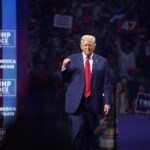If you are interested in world politics, the geopolitics of the Asia-Pacific, China and the United States, what’s the most enlightening source you have come across recently?
Well, let me share mine. But bear with me because you will probably roll your eyes and yawn. That was my reaction because the title itself put me half to sleep when an erudite source referenced it to me: “[US] Senate Energy Committee Hearing on Compact of Free Association Amendments Act.”
I know, the title doesn’t invite enthusiasm, but this two-month-old, one-hour and 40-minute clip has been viewed more than 7,100 times on YouTube, so those in the know recognise its importance. In fact, it has enormous implications for the US-China rivalry in the Pacific that we are rarely, if ever, told about.
If you think you know Washington’s real positions on such matters as exclusive economic zones (EEZs), freedom of navigation (FON) in open or international waters, and territorial waters – all being definitions crucial to what we are told about China’s expansionism in the South and East China seas – you really should watch this clip.
First, what are the Compacts of Free Association? Second, why has the White House rolled out the red carpet with President Joe Biden personally meeting leaders of the Pacific Island states this week?
These tiny islands have been routinely ignored for decades until China supposedly started spreading its influence in the region, for example, by making the security deal with the Solomon Islands.
The Pacific island summit this week includes Australia, Cook Islands, Federated States of Micronesia, Fiji, French Polynesia, Kiribati, Nauru, New Caledonia, New Zealand, Niue, Palau, Papua New Guinea, Republic of the Marshall Islands, Samoa, Tonga, and Tuvalu.
But the compact refers specifically to the strategic, defence and economic pacts which Washington has long made with the Marshall Islands, Palau and Micronesia. While those pacts don’t expire per se but may be terminated by the parties, most US economic aid and subsidies will expire on Saturday while others will end next year. Palau and Micronesia have already renewed their pacts; the Marshall Islands is expected to be on board with a sweetened deal from Washington.
All very well. With the Chinese closing in, why shouldn’t Washington step up aid and military assistance to counter Chinese influence? Well, it’s much more than that.
While notionally sovereign, those island states have been de facto US overseas colonies, as the pacts allow the US to take full defence and strategic control of their lands, seas and air
As it turns out, and the video clip makes clear, the US now considers the new pact as entitling it to control almost the entire central Pacific by virtue of its control of the three island states’ EEZs. This amounts to a new interpretation which allows the US the right to deny other countries or entities from sailing into those zones.
(Go to 49 min, 30 seconds on the YouTube clip for a very clear and concise map of the full extent of maritime control the US is asserting with the new pacts.)
Thus Republican senator and ranking committee member John Barrasso said: “The compacts provide us with strategic denial rights. This means the United States has the exclusive authority to make national security decisions on the lands and waters surrounding the freely associated states. The space outlined on this map in orange is the exclusive economic zones of the freely associated states … It’s nearly as large as the continental United States.”
US Deputy Assistant Secretary of Defence Siddharth Mohandas then elaborated on Barrasso’s remarks: “The combined maritime expanse covered by the freely associated states is equivalent to the size of the continental United States, in a key strategic terrain in the Indo-Pacific. What we get from Title 3 of the compact are two fundamental things: One is unfettered access, access to bases and overflight, which allow freedom of operations in the area. And the second is exclusive access: we have the ability to deny foreign military access and their ability to operate in the exclusive economic zones of the freely associated states. This is critically important at a time when China is increasingly active and aggressive throughout the Indo-Pacific.”
While Taiwan falls within the first island chain of attack or containment against mainland China, the whole of the central Pacific, not just the second island chain within it, is now effectively a US sphere of influence.
Joseph Yuosang Yun, the US special presidential envoy for compact negotiations, made this point at a separate presentation at the Washington-based Hudson Institute in April.
He explained that the Freely Associated States lying between Hawaii and the Philippines are crucial to the United States remaining a Pacific power.
“[The Marshall Islands, Palau and Micronesia] are the second island chain in defining its historic territorial claims across the Pacific,” Yun said. “Anyone with ambitions wants to control [the] waterways.”
Well, he would say that, wouldn’t he? In great power rivalry, none of those claims are particularly outrageous; indeed, rather quite understandable. However, the US has claimed both the legal and moral high grounds with respect to EEZs and freedom of navigation, including its naval access, through China’s EEZs. The argument is that anyone can, by international law, sail through anyone else’s EEZs.
A new article in Foreign Policy in Focus explains this point quite well: “In fact, US officials have long taken the position that exclusive economic zones must remain open to navigation. Across the world, they have promoted ‘freedom of navigation’, which they have presented as the freedom of ships to sail the world’s oceans and waterways wherever the law allows, including in the exclusive economic zones of other countries.”
Just to clarify some terms, sovereign or territorial waters, the maritime equivalent of sovereign land, extend from shores to 12 nautical miles. From there out to 200 nautical miles is what people usually call EEZs.
As the same article has pointed out, using a country’s navy and/or those of its allies, as the US has frequently done, to sail through others’ EEZs to demonstrate FON is not only provocative, but in breach of international law.
As stated in Articles 87 and 88 of the United Nations Convention on the Law of the Sea, “the high seas shall be reserved for peaceful purposes”.
Of course, the US position is to have its cake and eat it too. It has never ratified the UN convention, yet claims it fully supports it and has unscrupulously cited it against others who have signed and ratified it when it suits Washington’s purpose.
But with the renewed Pacific island pacts, it has gone beyond the “having your cake and eat it too” hypocrisy; it is claiming the exclusive right of denial to access by other countries’ navies and possibly other maritime assets to the island states’ EEZs, a right Washington has denied to others. And yet, it claims those island states are “sovereign”!
Moreover, as the Foreign Policy in Focus has observed, the new expansive interpretation of EEZ strategic control contradicts the US government’s own previous interpretation. According to the US General Accounting Office (GAO) in 2002, the pacts only allow US exclusive defence and strategic control of the island states’ territorial land and waters, but not EEZs.
Of course, those of us who have made a serious study of the history of US foreign policy would not at all be surprised. US self-defined exceptionalism has always been a case of “do as I say not as I do”.
But when it comes to the fate of the region if not the world, this stealthy US exceptionalism and expansionism need to be broadcast as widely as possible so the world knows the terrible danger to which Washington’s rivalry with China is exposing all of us.
Source : SCMP






































